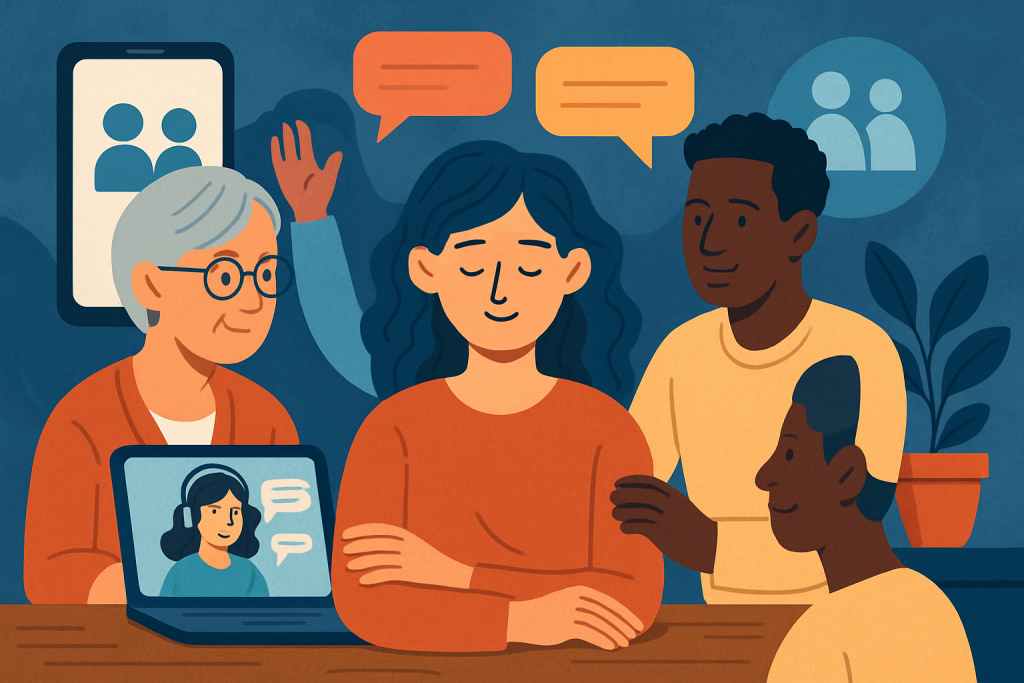Building a support system for mental health is more critical—and accessible—than ever before. Thanks to peer-led programs, digital tools, and integrated care innovations, millions are finding ways to stabilize and improve their emotional health. Whether you’re navigating daily stress or managing long-term mental illness, establishing a solid support network is no longer optional—it’s essential.

Why Mental Health Support Systems Matter
A reliable support system plays a pivotal role in mental health management. According to research from the University at Buffalo, strong interpersonal relationships are linked to better recovery outcomes, increased resilience, and enhanced psychological well-being (University at Buffalo, n.d.). Mental illness, often accompanied by social withdrawal, benefits greatly from consistent human connection.
Support systems can:
- Offer emotional safety during crises
- Encourage treatment adherence
- Provide practical help (transportation, reminders, childcare)
- Combat isolation and loneliness
Keyphrase: How to Build a Support System for Mental Health
What Is a Mental Health Support System?
At its core, a mental health support system is a network of individuals, resources, and services that help maintain psychological wellness. This includes family, friends, healthcare providers, peer support groups, and digital platforms. Today’s systems are increasingly hybrid—combining traditional support with tech-based tools for holistic care.
Step 1: Start With Personal Relationships
Often overlooked, personal connections form the bedrock of a healthy mind. Loved ones who are present, non-judgmental, and reliable can act as the first line of support.
How to Strengthen These Ties:
- Schedule regular check-ins via call or text
- Be vulnerable about your mental health needs
- Ask specific, actionable favors (e.g., “Can you walk with me weekly?”)
Personal networks aren’t just emotionally supportive—they’re often practical allies in navigating care logistics.
Step 2: Join Peer Support Groups
Peer support is gaining recognition as a cost-effective and empowering option. Groups led by people with lived experience provide empathy, understanding, and validation that traditional settings may lack.
According to Mental Health America, peer-led programs improve treatment engagement and reduce symptoms for individuals with depression, anxiety, and PTSD (Mental Health America, n.d.).
Popular Peer Support Channels:
- NAMI Peer-to-Peer: Educational program for adults with mental illness
- Facebook & Reddit Groups: Topic-specific support communities
- Clubhouse/Discord: Real-time chat rooms for various conditions
Step 3: Embrace Digital Mental Health Tools
The pandemic accelerated telehealth adoption, and now digital mental health support is mainstream. From therapy apps to AI chatbots, these tools make mental health resources more accessible.
Top-Rated Digital Platforms:
- BetterHelp / Talkspace: Online therapy from licensed professionals
- Woebot / Wysa: AI-powered chatbots using CBT techniques
- Calm / Headspace: Mindfulness and meditation tools
The National Institute of Mental Health emphasizes that these tools offer early intervention and supplement in-person therapy (NIMH, n.d.).
Step 4: Use Integrated Care Services
In 2025, integrated care models—combining physical and mental health services—are rapidly expanding. Patients can now access psychiatric help during regular doctor visits, reducing stigma and increasing continuity.
According to Axios, insurers are now investing more in primary care centers that include behavioral health, proving that the healthcare system recognizes the urgency of mental wellness (Axios, 2025).
How to Find Integrated Care:
- Ask your primary care provider if mental health services are co-located
- Look for “collaborative care” models in your insurance network
- Visit community clinics that offer multi-disciplinary services
Step 5: Identify Crisis Resources
No support system is complete without a crisis plan. Knowing who to call during emergencies can save lives. This includes suicide hotlines, walk-in clinics, and designated support persons.
Must-Know Crisis Tools:
- 988 Suicide & Crisis Lifeline (U.S.)
- Text HOME to 741741 for Crisis Text Line
- Local Mobile Crisis Units (available in many counties)
- Safety Plan Apps (e.g., My3 App)
Step 6: Explore Community Programs
Many non-profits and municipal programs offer free or low-cost support, especially for underserved populations. These programs often blend counseling, job training, housing support, and more.
Examples:
- The Friendship Bench in Zimbabwe offers accessible therapy via trained community members (Wikipedia, 2024)
- YMCA / Urban League Programs: Often include youth and adult mental health support
- Faith-Based Counseling: Available through churches, mosques, synagogues
Step 7: Consider Workplace and School-Based Support
In 2025, mental health support is a workplace priority. Employers are offering Employee Assistance Programs (EAPs), while schools are implementing mental wellness curricula.
Workplace Options:
- Free Therapy Sessions via EAPs
- Mental Health Days Off
- Onsite Counseling or Helplines
School-Based Models:
- Mental Health Clubs
- Peer Mentorship Programs
- Licensed School Counselors
These environments can be a first point of contact, especially for those hesitant to seek formal help.
Step 8: Normalize Mental Health Conversations
Culture change begins at home. Normalize discussions about mental health by using open, supportive language. Share your journey to encourage others and create safe spaces.
Pro Tip: Use person-first language—say “person living with bipolar disorder” rather than “bipolar person.” It matters.
Step 9: Stay Up to Date With Trends
The landscape of mental health care is evolving fast. New trends such as trauma-informed therapy, psychedelic-assisted therapy, and AI-driven diagnostics are reshaping care.
According to Mahalo Health and Halo Mental Health, 2024 saw significant advancements in using AI for personalized care and trauma-informed digital services (Mahalo Health, 2024; Halo Mental Health, 2024).
Emerging Trends to Watch:
- AI chatbots integrated into insurance portals
- Virtual Reality (VR) therapy for PTSD
- Online therapy that adjusts based on user mood
Conclusion: Build Your Mental Health Safety Net Now
Learning how to build a support system for mental health isn’t just about resources—it’s about intention. In 2025, options are more varied and accessible than ever. From peer support groups to AI-powered therapy, integrated care clinics to grassroots programs—building your own mental health ecosystem is possible.
Don’t wait for a crisis. Start mapping your network today. Remember, support systems aren’t just for emergencies—they’re the foundation for thriving.
References
- University at Buffalo School of Social Work. (n.d.). Developing Your Support System. Available at: https://socialwork.buffalo.edu/resources/self-care-starter-kit/additional-self-care-resources/developing-your-support-system.html (Accessed: 2 June 2025).
- Mental Health America. (n.d.). Peer Support: Research and Reports. Available at: https://mhanational.org/peer-support-research-and-reports/ (Accessed: 2 June 2025).
- National Institute of Mental Health. (n.d.). Technology and the Future of Mental Health Treatment. Available at: https://www.nimh.nih.gov/health/topics/technology-and-the-future-of-mental-health-treatment (Accessed: 2 June 2025).
- Axios. (2025). Insurers Warm to Behavioral Health in Primary Care. Available at: https://www.axios.com/2025/05/27/integrated-behavioral-health-rising (Accessed: 2 June 2025).
- Mahalo Health. (2024). Latest Technological Trends in Mental Healthcare in 2024. Available at: https://www.mahalo.health/insights/latest-technological-trends-in-mental-healthcare-in-2024 (Accessed: 2 June 2025).
- Halo Mental Health. (2024). 7 Mental Health Trends to Watch in 2024. Available at: https://halomentalhealth.com/b/mental-health-trends (Accessed: 2 June 2025).
- Wikipedia. (2024). Friendship Bench. Available at: https://en.wikipedia.org/wiki/Friendship_bench (Accessed: 2 June 2025).






